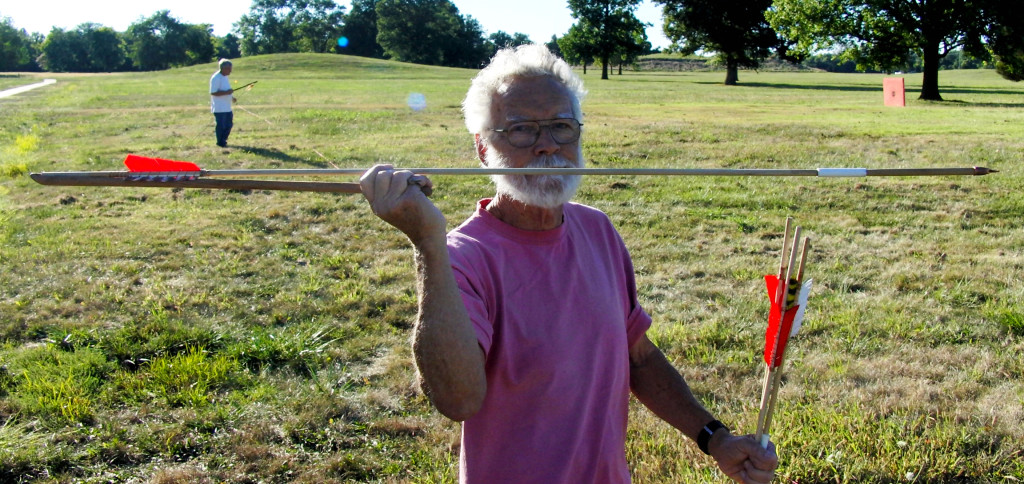By Ray Madden
In The Atlatl, volume 27, number 1
January 2014
The recent good article on Basket maker equipment by Justin and Devin, got me to reminiscing about the early days of my atlatl meet experience. The first competition I attended was at a primitive bow shoot in Marshall, MI. Prior to seeing the ad for that shoot in Primitive Archery Magazine, I was unaware that anyone else even threw atlatls. I had recently retired and having never visited the state of Michigan, the wife and I decided to make the trip. I was thrilled to meet others who loved not only the primitive bow, but the atlatl as well. I learned there was a Michigan Atlatl Association and joined it. Then I learned there was a World Atlatl Association, and joined it too. Gas was cheap then and we spent the next few years hitting every throw we could and visiting States, Parks, and Museums we’d not had time or opportunity to visit during our working years. Someone gave my name to the Wall St. Journal and they sent a reporter around to do an article on the Atlatl. Although the article only gave my name and city, a lot of people were interested enough to get my phone number through information and called me with further questions. Because of that I offered to send out a “cobbled together” information sheet to anyone who would furnish their mailing address. The number of such mail outs finally reached something between seventy five and a hundred (Many more than I’d expected!). Looking over that old original that I put together to copy for mailing, I was struck by the poor spelling, bad grammar, and crude sketches. But I was also reminded of the equipment I was using then. Because some contests then required three darts to compete, and because I was then throwing basket maker and sometimes “single-hole” atlatls, those were the atlatls I had illustrated and explained. In order to have a dart that anyone could obtain in matched sets of three, I had designed a “lumber yard” basket maker dart. It consisted of a 48″ dowel of 3/8″ diameter joined to a 9″ long section of 1/2″ dowel, by a 3″ section of plastic water pipe that was 1/2″ outer diameter and 3/8″ inner diameter and a point made of a 1 to 2 inch section of copper tubing crimped at the front. While it left something to be desired compared to the good willow darts I preferred, it was easily made, cheap, and could be made close enough alike to obtain a set of three, that would throw similar.
This trip down memory lane took me back to the local “Lowe’s” lumber yard. The grey plastic water pipe, no longer available, was replaced by 3″ of “PEX” tubing, the 1/2″ foreshaft replaced by 7/16″ and reduced to 8″ in length, and the copper tubing point cut to one and a half inch length, and crimped at the front at each quarter forming an “X” when viewed from the front. A single long feather was cut into thirds and tied so as to end about three inches from the nock, which was a simple hollow made with the point of a knife (For reasons I don’t fully understand, I get better flight with these three short feathers than those fletched with long feathers). In assembly, the four ft. dowel is marked 2 inches from one end and the plastic coupler is hammered on with a wood paddle or board down to the mark. The fore shaft is driven into the point with a hammer, then tapered slightly at the wood end and driven into the protruding 1 inch of plastic coupler by bouncing the dart, point down, on a hard surface such as a sidewalk or rock. Fletching is up to the individual. I like to tie fletching rather than glue it, because it offers many advantages that may be unique to me (Glue doesn’t bond well to shafts that have been waxed to prevent moisture absorption, and feathers can be quickly removed and reused or replaced in the field if tied on rather than glued). I like my feathers to be at least 3 inches from the back of the dart, but that’s individual preference too as I throw a variety of atlatls and fletch at the extreme end of the dart interferes with some atlatl hook designs.
Throwing these short cheap darts brought back more memories and while you probably won’t score in the high 90’s with them, they are excellent for getting kids and newbies started. I think short darts are under rated. Those of us who’ve see Justin and Devin throw have been reminded of what the basket makers and the Eskimos knew. A dart need not be long, to be effective. This dart weighs 2.2oz (64gms), and is around 55″ to 56″ (low 140cm.s) in overall length and is effective on small game as is. Very handy here in our thick Missouri brush! Total cost at this writing will run from just under $1.50 to just under $2.00 per dart, depending on whether you have to buy the feather or use something you can pick up free (I’ve used goose, turkey, and even chicken and crow). Fun to make and fun to throw and a great way to get a kid started.
(Ray is a great person to be around and a very knowledgeable atlatlist. Thanks for the great article Ray! ~Devin)



